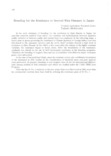Breeding for The Resistance to Several Rice Diseases in Japan
Tropical agriculture research series : proceedings of a symposium on tropical agriculture researches
| ISSN | 03889386 |
|---|---|
| 書誌レコードID(総合目録DB) | AA00870529 |

本文フルテキスト
tars21-_290-290.pdf121.5 KB
In the early attempts of breeding for the resistence to blast disease in Japan, the pure-line selection method from native rice varieties and hybridization between Japanese paddy varieties or between paddy and upland rices was employed. In the following stage, a major gene or genes governing the resistance in Chinese japonica or foreign indica rices was introduced to the Japanese varieties and the newly bred varieties showed a high level of resistance to blast disease. In the 1960's, a few years after the release of the highly resistant varieties, the resistance began to break down. After the breakdown of the resistance, emphasis was placed on the use of field (horizontal) resistance in the breeding programs. Therefore the breeding of isogenic lines and use of multilines with different major resistance genes were advocated.
In the case of bacterial leaf blight, since the resistant variety also exhibited a breakdown of the resistance in 1958, studies on the classification of bacterial races and gene analysis were performed. At present, breeding of near isogenic lines of rice for international differentials, testing method of field resistance and others are studied under the TARC/IRRI Joint Program.
After the line St No. 1 resistant to the rice stripe virus was discovered in 1962, more than ten commercial varieties have been bred by utilizing the resistance gene of St No. 1.
In the case of bacterial leaf blight, since the resistant variety also exhibited a breakdown of the resistance in 1958, studies on the classification of bacterial races and gene analysis were performed. At present, breeding of near isogenic lines of rice for international differentials, testing method of field resistance and others are studied under the TARC/IRRI Joint Program.
After the line St No. 1 resistant to the rice stripe virus was discovered in 1962, more than ten commercial varieties have been bred by utilizing the resistance gene of St No. 1.
| 刊行年月日 | |
|---|---|
| 作成者 | Tadashi MORINAKA |
| 公開者 | Japan International Research Center for Agricultural Sciences |
| 巻 | 21 |
| 開始ページ | 290 |
| 終了ページ | 290 |
| 言語 | eng |
